For A Sparkling Stained Glass Finish
This stained glass tutorial exposes the myth of polish and wax. In I share expert tips on polishing, applying patina and waxing copper foiled projects. This is the last thing to do before hanging your finished panel up for everyone to admire. It takes a fair bit of effort, but – as always – is worth spending time on to get a sparkling even finish.
Stained glass patina comes in black and copper, with each needing a slightly different process. This stained glass tutorial concentrates on copper, with additional notes about what to do if using black patina.
Jump down for Frequently Asked Questions about Patina
If you struggle to get an even finish with patina or suffer with that horrible white residue I have some ideas to help you out. You might find them surprising.
My Stained Glass Made Perfect course has helped many people achieve a better finish to their projects. After all that effort you deserve a shiny panel! The course is self-paced and online so you can learn these polish and patina techniques even if you are unable to get to a class. You can find out more about it here Stained Glass Made Perfect.
What You Need
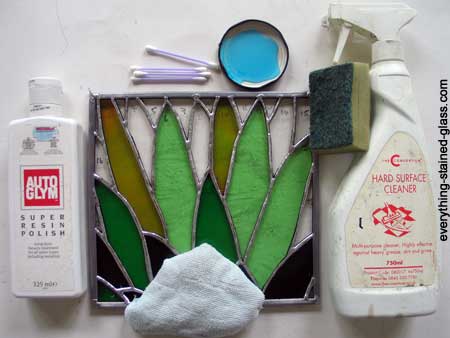
Green scrubby, Q-tips, Copper Patina (paid link), Wax, Polish, Soft cloth, Toothbrush, All Purpose cleaner, Paper towels, Access to water.
Make sure you’ve got the correct patina. There’s different Black Patina for lead and solder (paid link) and another type of black patina for zinc (paid link). Patina doesn’t work on lead free solder.
Stained Glass Tutorial – Patina and Polish
1. Cleaning Tutorial
It’s very important to do this thoroughly to remove any acids from the flux. Baking soda in the water can help reduce the white ‘crusting’ that sometimes forms. Some people swear by copper sulphate for cleaning. If you don’t have access to water you can use Flux remover Kwik-Cleaner (paid link). It works really well and helps prevent mouldy patina.
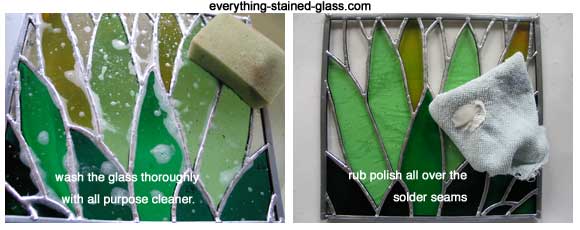
- Clean all the flux off the solder with all purpose cleaner. You can buy flux remover for this, but all purpose cleaner works just as well
- Put lots of cleaning fluid on and make sure it froths up
- Go over every solder seam thoroughly. You can use a toothbrush if it helps
- Dry it off with a paper towel
- Your solder should now be silver
- Next you have to polish the solder. Yes, you did read that correctly; polish first before patina.
Exposing The Polish and Wax Myth
Most people – including me many moons ago – were taught to polish last thing. But I’d like you to think again about this…
Polish contains an abrasive element. As such it is better used for the final clean before patina or wax. It gets rid of the very last of the grime off your solder lines. That’s why the cloth still picks up black dirt when polishing.
Some people complain that their final polish removes the patina they’ve just put on… can you see why this is happening? Correct; because the abrasive element removes the patina.
They go around in circles putting patina on and accidentally polishing it off.
Roadmap
After experimenting over the years with different polishes, patinas and waxes I have developed this roadmap:
Clean >> Polish >>> Patina (optional, if you want your solder lines a colour other than silver) >>> Wax
You may have to experiment with the different brands but I’m confident that this roadmap will help you produce a lasting shiny finish.
2. Polishing Tutorial
I use a standard car polish. If you’re using black patina, you don’t need to polish at this stage, go straight to 3. below.
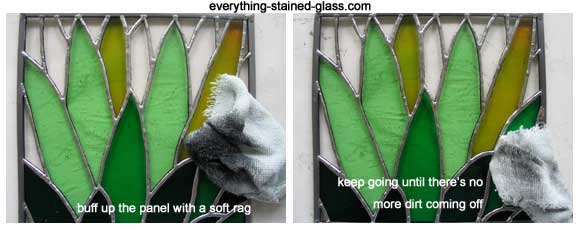
- Put some polish on a soft rag and rub over the panel
- Keep buffing it up until the black residue all but disappears (where does all that black come from?!)
- If you want your panel silver, you’re done with this stage – only waxing left!
3. Stained Glass Patina Tutorial
Some people have trouble with patina being dull or not ‘taking’. This could be down to minerals in the water where you are. If this is the case, try buying distilled water and using it for the final rinse. I’ve found that there’s always a degree of experimentation with stained glass!
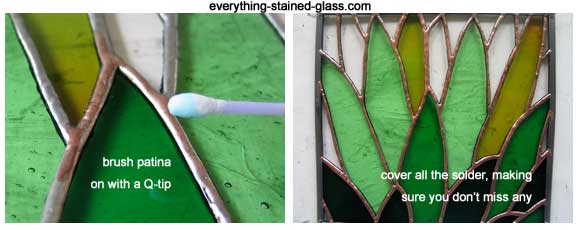
- With a Q-tip or cheap brush, apply the copper patina to the solder seams.
- Don’t be mean with the patina, and make sure that you cover every last bit of the solder
- Dry thoroughly with paper towel
- Let the panel air dry before the final polish with wax. I leave mine on my easel so that both sides can dry
4. Final Buff Up With Wax
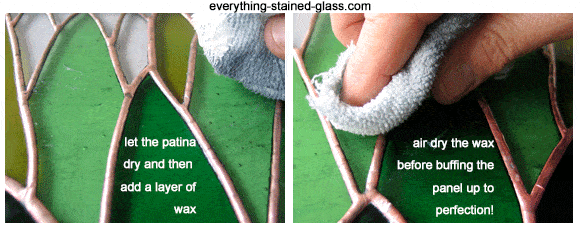
- Repeat 2. above, but this time using wax instead of polish.
- Let the wax dry completely before buffing
- For ongoing sparkliness, simply repeat these Final Buff Up instructions every so ofter to make your panel as good as new.
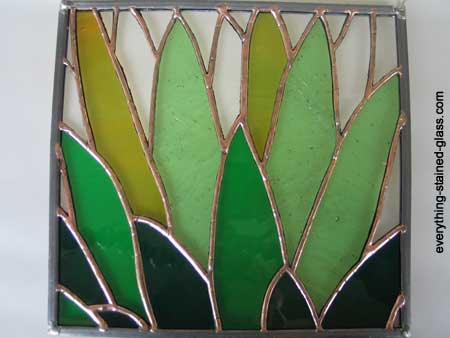
FAQ – Common Patina Questions Answered
1. Question: My zinc is blotchy after patina
Milly’s Answer:
A good even, black zinc patina is notoriously elusive so you might have to experiment a bit with the different ingredients. This method works for me:
- Clean the zinc with fine damp steel wool, wipe the zinc to clean all particles off the surface. Use gloves and a mask
- Apply one coat of patina – I recommend Novacan Black Patina for Zinc
- Let it dry and then go over the zinc a second time with steel wool
- Wipe with cloth
- Apply a second coat of patina
- If the colour isn’t even, repeat the process
2. Question: How do I get stained glass flux off so that it doesn’t produce white mould?
Milly’s Answer:
- You can use KwikClean to get the flux off (recommended), or soap and water.
- Baking soda sprinkled on before washing can help with white mould.
- I use polish to rub off all the invisible gunk off the solder lines before applying patina. Then wax to finish.
3. Question: Does patina stain glass & leave a film on it?
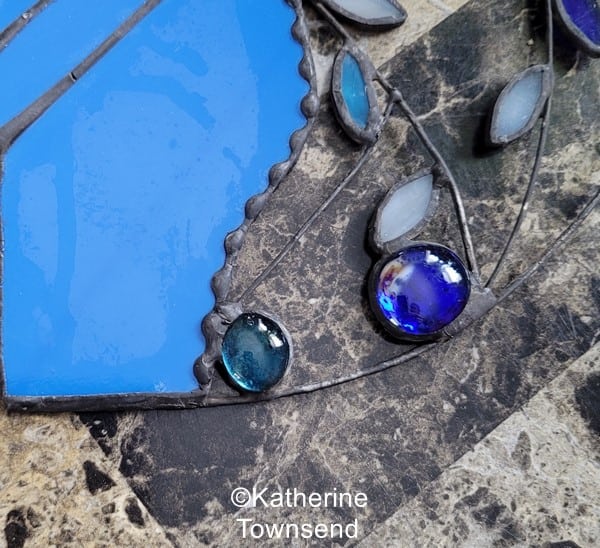
Milly’s Answer:
Yes. Patina can stain certain glass if it’s not washed off the glass soon after applying (see blue glass in image, above)
I always advise doing tests beforehand if you’re unsure but removing stained glass patina swiftly off the glass should fix the problem.
If it’s too late and the glass is stained, try powdered Bar Keepers Friend here (paid link)
It is a non-abrasive stain remover. Sprinkle some of the powder where you need it, add a little water to make a paste, rub the mixture around the stained area on both sides of the glass, let it dry to a haze, and rinse several times with cool water.
I haven’t tried this so can’t vouch for this.
4. Question: My stained glass patina ends up whitish & cloudy
Milly’s Answer:
Stained glass; sometimes you do EVERYTHING the same as before and suddenly you have white mould. Sigh.
White mould is normally the result of not removing the flux well enough rather than the patina.
To get rid of it you’ll have to rub the patina off. Using one of those green scrubber things is less horrid than using steel wool.
You could try a different wax, I recently found Renaissance Wax which is used for heritage works. It seems to offer good protection for the seams.
You can read about it here:
https://everythingstainedglass.com/recommended-tools
5. Question: How do you use a Dremmel to make stained glass polishing easier?
Milly’s Answer:
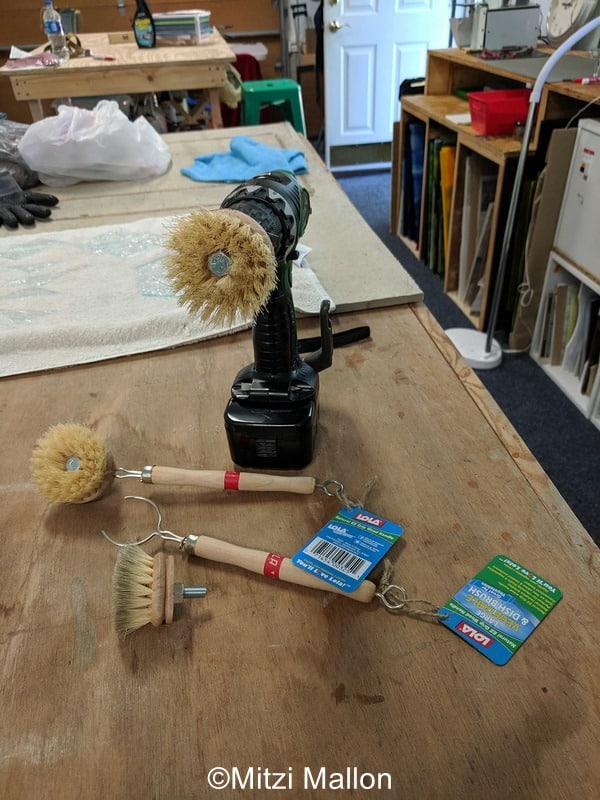
There are some amazingly creative solutions to be had here. I still use muscle but am definitely going to move to machine power soon 😉
- These inexpensive vegetable brushes – see image (paid link) work extremely well. Drill a hole in middle of the brush, add a nut and bolt. Make sure the bolt is long enough to be inserted into the drill. The bristles are natural and don’t cause any problems to the glass or solder lines. When wax builds up in the brush, wash it in hot soapy water to clean. Thanks Mitzi Mallon.
- You can also use a cloth buffing wheel in a standard drill, shoe shine brushes and horse grooming brushes.
Helpful Resources
At 9 minutes, this stained glass tutorial is a bit long, but if you come in at 2mins 30secs you’ll hit the most useful bit. It’s definitely worth watching.
Stained glass video tutorial on patina
You’re done! You now have a bright shiny copper masterpiece ready to hang. Congratulations 🙂
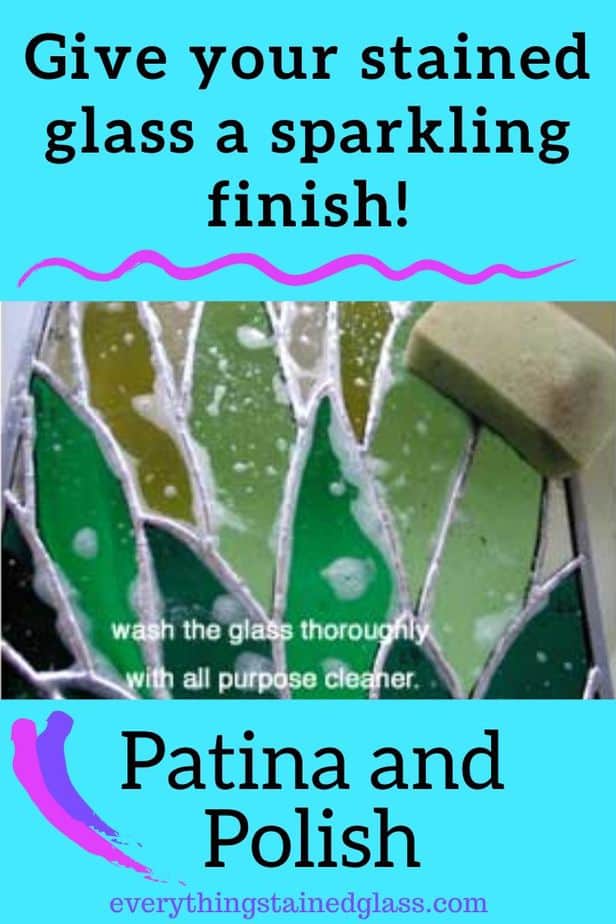
Stained Glass Soldering Temperature

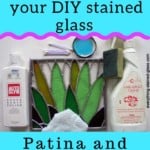
Bonjour, je souhaiterais prendre le risque de mettre un vitrail Tiffany en extérieur, en imposte. En effet, je n’ai pas la place, dans la feuillure, de poser un vitrage de protection.
Est-ce que l’on connaît la durabilité d’une telle installation et, il y a t’il des précautions à prendre: largeur de cuivre, patine…?
Merci beaucoup
Hello, I’d like to take the risk of installing a Tiffany stained glass window outdoors, as a transom. I don’t have the space in the rebate to install protective glazing.
Do we know how durable such an installation will be, and are there any precautions to take: copper width, patina, etc.?
Thank you very much.
I’d suggest using lead came rather than copper foil for windows that are outside. They were installed for hundreds of years without any problems.
However, what they will be is colder than your normal 21st century windows, so you might not want to do this if your door leads straight into your home. Or you may not mind – in which case, you have to take account of measuring up properly as per this tutorial:
https://everythingstainedglass.com/how-to-make-stained-glass-1
You can use Google Translate as I have here 🙂
Je suggère d’utiliser des feuilles de plomb plutôt que du papier aluminium pour les fenêtres extérieures. Elles ont été installées sans problème pendant des siècles.
Cependant, elles seront plus froides que vos fenêtres classiques du XXIe siècle ; il est donc préférable de ne pas le faire si votre porte donne directement sur l’intérieur. Ou peut-être que cela ne vous dérange pas, auquel cas, il est important de prendre les mesures correctement, comme indiqué dans ce tutoriel :
https://everythingstainedglass.com/how-to-make-stained-glass-1
Vous pouvez utiliser Google Traduction, comme je l’ai fait ici 🙂
Hi Millie
Sorry a rather boring question but what do you use to polish &/or wax copper foil seams with?
Many thanks
Hilary
Hi Hilary, I use Renaissance Wax to finish. I hope that helps.
I used black patina on my stained glass lampshade. I was disappointed with the result as it looked too dark and dull. I prefer the silver colour of the solder. I am now trying to remove the black patina with steel wool. Is there something I can use which makes it much easier to remove the black patina please?
Your solutions to the questions are very interesting Milly.
I live in New South Wales, Australia.
May I be added to your list to receive stained glass tips please Milly?
Kind regards,
Jennifer
You can use one of those green scrubber pads Jennifer. Or Annie Sloane fine sanding pads if you can get them. The red one is the finest. They’re flexible and can be reused, all you have to do is wash them.
You can sign up to my tips here: https://everythingstainedglass.com/dazzle. Thanks 🙂
Hi Milly, We use Mother’s and 3M mag & Aluminum polish I have for my billet wheels to polish and wax. I have found that many times I can use a heavier galvanized chain or part for the glass suspension. I just solder the part or chain first, making sure it is completely covered, then add the patina. Next would be polish, buff, then wax. Usually get a good match to the project, if not it is easy to adjust.
That’s SO useful Richard, thanks so much for taking the time to share it with everyone 🙂
After trying a number of different techniques, I found that using whiting on a clean rag to polish my solder seams before using patina works well for me. ( No chemicals, no liquid to worry about and I also use whiting for a lot of other things also, like general glass cleaning, taking odd tape residue off, removing marker lines, and price marks off glass.) Then I patina and wax.
I do agree with a number of folks who mentioned that a good cleaning to get rid of the flux is the most important thing we can do to achieve good results!
Thank You, Millie for all you have done to teach and contribute to the knowledge base!
That’s a great tip Paul, thank you. I use whiting exclusively for leading but not for foiling… will have a go as it makes perfect sense 🙂
Hi again Milly.
I was reading Making Tiffany Lamps by Hugh V Archer. He talks about copper plating his solder in the first instance. That may be a step too far for me! He also makes his own patina by sourcing chemicals and mixing them together. Have you ever tried this? I’m thinking about trying to achieve an antiqued finish rather than the bright copper you get straight from a ready mixed bottle.
Best wishes
Chris
He’s a proper lamp expert 🙂 I agree, copper plating gives a beautiful finish but over the top for individual lamps.
I can’t help you with the mixing of patinas, sorry. Could you look it up on the Internet and see if anyone has any suggestions? I’d be interested in your findings. Good luck.
Well. I certainly went down a rabbit hole after your last suggestion. There is a huge amount of information about patina on the web. Have a look at this for example.
https://m.youtube.com/watch?v=yl67z6XmNiQ&pp=ygUNcGF0aW5hIGNvcHBlcg%3D%3D
I reckon I could get a reasonable antique look using a combination of some of the suggestions in the video. Still so much to learn!
Chris
Thanks for the YT link; as you say, there’s as many recipes for patina as there are stained glassers 🙂 I hope you find the one that suits your desired outcome. If so, come back and let us know.
Hi Milly.
Just wondering if ready-mixed patina in bottles has a sell-by date? Does its effectiveness deteriorate over time?
If you decant bits of it and throw the dirty stuff away rather than returning to the bottle it lasts for ages Chris. I’ve used the same patina for years with no change. Whether manufacturers say the same I don’t know.
I hope that helps.
After reading these comments a have found a couple of things that work for me.
1 – I use white vinegar, baking soda, or a combination of the two to help clean off the white mould. Rinse with hot water, dry with cloth, then polish etc
2 – I have tried nail polish, but it flakes off to easily for me.
3 – For my students with shaking hands, I find that a long block of padded wood that can keeep the heel of the hand elevated but still provides support can help a bit.
Good idea about the padded wood, makes sense.
Thank you Terri for taking the time to share your tips. Everyone will appreciate them I’m sure.
I went to a copper foil stained glass workshop recently and was a bit rushed at the end. I had to pick quickly if I wanted a copper or black patina or to leave it silver, and I picked copper, but don’t love how it looks now. I feel like it popped more as silver. Is there any way to remove the copper patina?
Fine dampened steel or brass wool will remove it Amanda. I have heard rubbing alcohol works but haven’t tried so can’t be sure. Bit less messy if it does!
Hi Milly,
Do you wash the excess polish off before you add patina? Thanks for all the tips!
Yes I do Georgia. Then patina, then wax. I hope that helps.
Recommend “D-Lead” hand soap to your students to get rid of acids and chemicals in the solder (I.e. lead). It’s available at most glass suppliers and on Amazon. Not expensive. Save old empty hand soap dispensers and buy by the gallon.
Great tip Sharon, thanks so much 🙂
Hi, I’m new to copper foiling glass and I am making round tealight holders. Please can you tell me if i should wash all my individual pieces of glass once I have foiled and tinned them? Or should I go straight onto tacking the pieces together to form the tealight holder like I am doing at the moment. I am finding that my finished items are not pleasing to the eye on the soldering. The soldering is very rough and has grey/black bits in it. I do hear crackling when I solder I presume this is the flux? Once I have applied the patina copper or black the colour is very uneven and dull. I do clean the finished item well before applying the patina. Hoping that you can help, I don’t want to give up so early into my new hobby but just can’t seem to get the soldering to look good. Thank you.
You don’t need to wash after tinning. Just wipe the flux and start tacking. You can try wiping the flux off as you solder to keep it cleaner if you’re having trouble with the finished look.
I hope that helps.
I agree! I don’t understand the whole clean, polish, then patina, clean and polish or wax again thing. After soldering I only spray with a mixture od water, Dawn and vinegar, then rinse and dry. Have good results. Patina, wash and then polish/wax.
Thanks for sharing your process Bruce. I do think we can get a bit to hung up on ‘perfect’ patina; with the light behind it eclipses a few uneven blotches 🙂
You might be using too much flux.
Hi Milly,
1. I find that burnt on flux comes off well with alcohol? Is it ok to use this on copper foiled stained glass.
2. Where do you buy kwik clean from in the uk?
3. Which wax do you use please?
Thanks,
Mandy
Yes, you can use alcohol rub on stained glass Mandy.
You can buy Kwik Clean at Creative Glass Guild in Bristol.
I use Renaissance Wax. I find it works very well for the reasons on this page: https://everythingstainedglass.com/recommended-tools
I hope that helps.
Hi Milly,
Many years ago when I was making Leadlight panels. I cleaned the panel with chalk dust, I believe the reaction with the chalk and putty and lead gave the panel a patina finish. it also brought up the glass very brightly.
Thanks for the tutorials. I am about to start my first panel.
Thanks Greg, me too. The lead came finishing process is different and is detailed here: https://everythingstainedglass.com/stained-glass-craft. Good luck with your first panel.
I’ve been experiencing an odd issue lately. I clean my piece thoroughly with Kwik-Clean and a toothbrush, let it dry, then move on to the Liva polishing. The solder starts out nice and silver, then as I start wiping the polish on, it starts to turn the solder a nasty dark color instead of making it shiny. I pour the polish onto a clean cloth so I can’t imagine it’s been contaminated. I’m used to dark residue wiping off when I polish, but I don’t think it should be staining the solder. Any idea what is going on?
Perhaps the Kwik Clean isn’t doing it’s job properly and there is still flux on it. Flux residue is often the culprit. There are so many variables it’s tricky to nail it down sometimes.
Hi Milly,
I first did stained glass in the early’90’s.
It’s 30 years later, and I’m just getting started again. I took a refresher class. And got the basics. In class we wiped worth a damp paper towel. Then put patina on (black), and wiped off worth a damp paper towel after 9 minutes. Then did the other side. Then we put in the polish. I purchased the polish at the glass store. Is that the best to use? I saw in another comment, you use Mothers Auto Wax. I do have the whole Mother’s kit.
I’m now, after soldering, I wash with the Flux remove and then dawn. I like to leave silver mist often. Am I understanding, solder, wash with cleaner (dish soap? Awesome? Windex?)
Then polish. Wipe off and wax?
Sorry this is so long..
There are many many ways of doing the patina and polish Judi 🙂 People tend to experiment and find a way that suits them, taking into account all the factors that influence the results; which flux, solder, polish, patina, wax and even the water – they all behave annoyingly differently.
I remove flux with Kwik Clean after soldering but you can use soap and water as long as you dry thoroughly. Then polish which acts as a final clean of the solder. I use Simichrome or Glym Auto Polish (cheaper!), both have same results for me. Then patina, then Kwik Clean, then, finally, wax to protect from oxidation. I hope that’s clear.
I don’t sell supplies, I’m an ‘online classes girl!)
Milly how can I remove or redo a patina? Some tell me 0000 is not a good idea?
You can use a green scrubby or copper wool to remove it Roni. The steel wool is okay too if it’s dampened down but it does leave ‘bits’. Polish the solder well til its shiny, then finish off in your usual fashion.
As a long time stained glass professional and commission artist (30+ years), I’m a bit surprised that you use a cleaner of any type on your work. The #1 reason for patina problems is the accumulation of chemicals on your piece that you just don’t properly eliminate. Cleaners can be full of different chemicals that just get in the way. What has always worked for me is to ensure you use water-soluble cutting oil & flux, so there’s no need to add anything to your completed work except water during the cleaning process. I do agree that the abrasive in polish can be helpful but again, polishes also contain other chemicals that just require additional water washes. I find it easier and less of a problem to use a fine copper wool pad to abrade your solder lines slightly to ensure they are extremely clean prior to applying your patina. In my opinion, the best secret to patina success is to clean well with only water and ensure all chemicals you must use are water-soluble.
That’s an interesting read Christopher, thanks for taking the time to add it to the discussion. I guess chemicals were never an option at one point. I also think stained glass crafts people didn’t used to fuss so much about perfect patina LOL! I keep meaning to put together a book of all the differing thoughts on patina, to help people find the one that suits them the best. I’ll add yours if I ever get around to it 🙂
I just finished my first stained glass project using lead came. Do I putty first then patina? Or do I patina then putty? Will the patina affect the putty?
Thanks
rh
Congratulations Roger! Putty first, then clean within an inch, picking out all the stray bits of putty, then polish and/or patina. There’s more details and images on my page on cleaning and polishing lead came here: https://everythingstainedglass.com/stained-glass-craft
I didn’t use to polish my patina when i first started stained glass and now i have been doing it for a few years and i think my patina is even better looking, it works even better with copper patina.
That’s great to hear Magali, thanks for taking the time to share your experience.
I never heard of using polish before patina , I’ll have to try this next time thank you
It’s really to give the solder an extra clean before patina. It works for me but there are lots of variables to take into account. I’m a firm believer in trying things out and seeing what works best for your particular situation – different flux, solder, polish, patina, wax and even water – they all behave annoyingly differently.
I just finished soldering a large lampshade and need to clean any remaining wax from the inside. Odyssey is recommending heated kerosine but that seems a little scary!!
Any suggestions?
Thanks
Alan, I don’t profess to be an expert on this but I CAN direct you to the experts here the Association of Stained Glass Lamp Artists – http://www.asgla.com/FAQNews/newscontents.html – has an outstanding array of information. Good luck!
>Hello Mill. Before applying patina, I was taught to go over all of the solder lines with steel wool until they appeared shiny. I see that you are not recommending this – is that because you see the polish as a good replacement for the steel wool?
Essentially, yes. It gets rid of all the unseen dirt. I only use steel wool if the solder has oxidised, although it will work as you know! Good question, thanks Laurie.
Thank you for sharing so much. Why do you recommend skipping the polish step if using black patina?
Good question Sarah. Because it doesn’t seem to like the polish! I just wash, patina and wax. Or if you have dodgy water with lots of minerals you can try the following:
Use Kwik Clean or Invisible Glass to get the flux off, dry, wax, patina, dry, clean with KC or IG, wax again.
Referring to your last paragraph above do you REALLY mean WAX before patina??. Surely the wax would stop the patina ‘taking’ to the soalder???
And any recommendations for a good wax here in the U.K.?
It’s a misunderstanding which I’ve changed to make it clearer Stacey. The final paragraph means repeat Step 2 (polishing) using wax instead. I hope that clears it up.
If I am rubbing the solder until no black appears on my cloth, isn’t the wax gone by then?
It’s the polish (abrasive) you rub until there’s no black. The wax is the final step – you just buff that up.
I hope that helps.
Hi Milly,
I’ve been cleaning off the flux with Dawn dish soap, then I used the polish you recommended(Glym), then I applied the patina, but in addition to it turning the copper foil black, I get rusty film, and it impossible to get off without scrubbing off the patina. I’ve tried rinsing it with cold water, but there is always a bit that gets into some little crease or corner. I can’t figure out what I’m doing wrong.
I’m wiping off the polish, should I be washing the piece again? It also happened before I tried adding the polish into my routine, but now it’s worse. Any words of wisdom?
best,
Joanne
Oh no, we don’t want that Joanne. Is the panel scrupulously dry before the polishing step? Sounds like wet from the ‘rusty’ reaction. I don’t wash again after polishing, no, just patina and wax. I’ve use Kwik Clean instead of water to good effect. I know water can influence the procedure – there are so many different variables with solder, flux, patinas and water. Try doing some small tests with different combinations on test pieces and see if you can find one that works for you.
Thanks for your wisdom. The teacher I had directed us to put the Kwik Clean into a tray of water. I think this was her way of keeping costs down, and I’ve only just come to realize that that isn’t common practice. I’ll be sure do some tests, and to not use water after polishing, once I’m able to work again. I’m remodelling my laundry room so that I can have some space to work on glass projects, as opposed to using the spare bedroom.
Normally KwikClean is used instead of water. ‘Invisible Glass’ is another option, it’s hard to get in the UK and expensive but cheap in US and apparently effective. I haven’t tried it yet so can’t comment. Good luck 🙂
Thank you Milly! I’ve been doing this as a hobby for 10 years, and you answered my question in the first paragraph. Patina DOESN’T work on lead free!!! Problem solved. I used to go to a website called Stained Glassville forum, but it seems that has disappeared and Reddit isn’t super active when it comes to this stuff.
Oh great, bullseye LOL! Glad I could help.
I remember Stained Glassville, it was great. It’s a shame that these things ‘disappear’ – there was SO much information and knowledge shared on there. I guess FB has taken over 🙁
I am fairly new at this and loving every minute of making my stained glass suncatchers. (Almost a year now). I’ve been learning as I go, and appreciate all the tips that you post.
My question is mostly in keeping my solder shiny after the piece is done. I have received conflicting information. I currently clean my work with KwickClean. I have read some places that say NEVER clean with water, yet I see other information that says they are using water and dish soap. I finish with Liva Polish. I too am confused about the difference of Polishing and Waxing. In my mind, polish is to make it shine, and wax to protect. Is this correct?
I was just reading some of others questions, and I have always applied the Polish AFTER I use Black or Copper Patina. Should I be putting in on before?, and should I just be concentrating on then Solder at this point?
Should I be using some sort of a mild abrasive to remove all of the black? I have seen ideas of plastic scrubbier, or fine steel wool. Today, I thought I would experiment with a piece that I wasn’t too concerned about possibly ruining….I made it a few months ago, and the solder (no Patina) had dulled, and in fact had some “white-ish” marks on it. I used a dampened “ Mr. Clean Magic Eraser” lightly over the solder. The eraser got black, and the solder is super shiny!! Will this now stay? Should I be applying Polish over the lines now?
Also, should polish and wax be covering just the solder, or is it a protectant for the glass as well?
I am sorry that I have asked you so many questions here, and appreciate anything that you can clear up for me!
Thanks so much!! Rhonda
What I like about your comment Rhonda is the experimenting and testing you’re willing to try. This patina question is one that has as many answers as people; mainly because there are many variants.
I use polish – an abrasive which rubs off the invisible dirt off the solder before I apply patina. Then wax to finish/protect/buff and shine.
Not everyone does it this way, I understand that. I’m a firm believer in trying things out and seeing what works best for your particular situation – different flux, solder, polish, patina, wax and even water – they all behave annoyingly differently.
Are the materials used to polish and wax the same thing? Or two different wax and polish products? If so, what are the products you use? I have not seen two different products.
Thanks!
I use a car polish or Simichrome and Mother’s Wax. Two different products; one to clean and one to protect. I know others don’t find this approach helpful so I’d give it a try on a scrap piece and see if it works for you. There are lots of variables with solders, cleaning fluids – water even! It’s a bit of a minefield LOL.
I am sure you are tired of clarification for polish and wax by now. Growing up polishing and waxing were used interchangeably. I found this on google: Car wax protects the paint job of your car, acting as a barrier between the paint and the outside world. On the other hand, car polish enhances the appearance of your car’s paint job by removing smaller imperfections.
I live in the US and use Meguiar’s Cleaner Wax as my finish wax and it shines up beautifully and smells better than others car wax. As a fairly beginner I’ve not used a patina yet but look forward to trying and will try a car polish as you suggested too. Thanks for your newsletters.
That’s it in a nutshell Diana, thanks. Polish is a bit abrasive so will remove patina if used afterwards. Perhaps it got a muddled as a result of the word ‘polish’ meaning to bring to a shine? Which is what we all want.
I’ve not heard of Meguiar’s wax, thanks for the suggestion.
I have several completed pieces of stain glass my children have made over the years. I’m wanting to incorporate them all into one big piece. Can I safely solder them all together into one big piece. Planning on securing the finished product in a wooden frame to be viewed in one large window. It all sounds good in my head, just needing a professionals advice. This is something I have never done.
You can Debora, yes. What a lovely idea. You’ll have to remove any patina and make sure the soldered edges are clean. Think about possible reinforcing issues too; I have a page on reinforcing here which will point out pitfalls and solutions in that area. Good luck with it, I’d love to see it finished!
Hi Milly,
Thanks for the informative patina tutorial. I am not familiar with the polish-before-patina step, and will try it on the piece I am currently working on. After reading through other comments, the polish you recommend is simichrome or Carnuba wax system, step 3, which is one area of my confusion. How is a polish different from a wax since the carnuba is called a wax? Also, what final wax do you recommend? And, can glass cleaner like windex be used as the all purpose cleaner, or is there any particular cleaner you would recommend?
BUT here’s my patina question. I would like to use a copper patina on my stained glass piece and have a black zinc frame. I have always attached my solder lines to the zinc came with a little blurb of solder onto the frame. Would I use copper patina on the solder lines inside the piece up to the edge of the came, and then black patina for the zinc came and then dab all the solder blurbs on the came with black patina for solder? Do you think this would look blotchy? Does the black patina for solder and for zinc come out equally black with proper preparation?
Hello Beanne, regarding your confusion re-polish and wax – Simichrome is polish and Mothers Wax (obviously!) wax. When I recommended I meant one as a polish, the other as a wax. Sorry for any confusion.
The two different metals take solder differently so there will be a discrepancy. I’d use black patina on the solder blobs, as many times as it needs to approximate the colour of the zinc.
It would be easer to patina then solder wires if wanted. Solder will not stick to patina. What best process?
It’s best to solder first and then patina Maury.
Can you give me some recommendations on car polish and the wax you use?
The polish is called ‘Glym’ the wax is Mother’s Wax. I hope that helps.
ev*********@***il.com Hi Milly, I just love all your wonderful help! I am confused about ‘clean, polish, patina, wax’. I clean with dawn and nutri clean and do lots of frothing and rinsing, then I apply patina and rinse in cold water, once dry, I apply Liva stained glass polish, let it dry for about an hour and then when I buff I notice some of the patina comes off. Am I supposed to apply the Liva as the step before patina? So my steps could be solder; clean thoroughly, apply Liva Polish to the silver solder and leave on until dry and then buff; apply patina and rinse with cold water; then apply Mothers Wax at the end? thanks for your help.
Eva.
Polish has an abrasive element to clean the solder before patina, so yes, before patina. Wax at the end. Let us know how you get on.
Thank you for your articles. I am new to this (only @ 3 years). I am finding that I am rushing to get my items I make, done. I didn’t realize this. I will start taking more time to solder, polish, patina and wax.
Ah, taking your time Cindy… it’s one of the pleasures of stained glass 🙂 When you’ve spent all that time on it it seems a shame to rush the final stages.
I am just learning so this is a terrific tutorial and so very helpful.
Thank you for sharing.
Yay, another person getting drawn into the wonderful world of stained glass Judy, welcome 🙂 I’m glad you find the page helpful.
I have oxidized 40/60 solder that I had left too long without properly cleaning, so I used kwikClean and toothbrush and dried and washed with detergent and dried and kwikcleaned again and still have oxidized solder….what can I do to bring it back to life?
Try rubbing it with fine steel wool. Use a mask and gloves and vacuum up after as all the bits go everywhere. Then start again with your cleaning, patina and polish. Not the nicest job in the world! Good luck.
Hi Milly,
I’m new to stained glass and working on only my second project. It’s a round piece that I am giving as a gift (if it turns out ok!). The recipient loves copper and has a lot of it in her house, so I’d like to use a copper patina on the solder. My issue is, I don’t know how to make the frame copper. I thought I’d just buy some copper came, but from what I’ve read that doesn’t come in a material that can be used on a round piece and patina doesn’t work on the flexible lead came I would have to use. Do you have any recommendations on how to get the frame a copper color that would match the copper patina?
Thank you for any advice you can give me. I’v subscribed to your newsletter and have learned a lot!
-Melissa
Hi Melissa, you’re correct, it’s tricky. The nearest you can get to it is soft brass came but it’s not copper, it’s much yellower. I’d stick with the lead and have a lovely contrasting black. Big it up, don’t be apologetic. These are the material limitations we have to work within so it’s good to learn to celebrate them 🙂
You can use a variable speed drill to twist two copper or pre tinned wires together. Use that for the “frame” by soldering it around the edge. You can then use the copper patina with no problem.
Thanks for this great idea Kat, much appreciated 🙂
I have had success covering u-shaped lead came with copper foil and then tinnning it with solder and then using copper patina.
That’s an interesting workaround Sue, thanks for sharing.
I’ve never tried that so can’t comment but it would give you the opportunity of having matching solder and lead if you take the time to do it.
Dear Milly , I thank you so much for sending this mail .
My question is : do you use whiting for cleaning and in
which step ?
Whiting is basically a polishing compound – it’s fine chalk dust. I use whiting on new lead came projects to clean up the oil from the putty. You can also use whiting on copper foil, mainly for cleaning older windows that have years of grime. Sprinkle a handful of whiting over the whole panel. Take a stiff natural bristle brush and move the powder all over. Spray water mist all over the whiting until it becomes gooey. Let it dry overnight and then take the brush and polish it. This will get rid of old grime and accumulated unwanted ‘stuff’. Do one side at a time. I hope that helps.
Dear Milly thank you for your answer about whiting.
I do stained glass for many years only as a hobby and created nice things as I was told.I would like to send some to you to share for your students.How can I do this ?
Hello Levia, you can email them to me using my newsletter email. Thanks for thinking of me, I look forward to them.
Hi Milly, I’m enjoying your site. I’m confused on the polish, then patina, then wax. I have used polish and wax interchangably, perhaps incorrectly. What do you recommend for a polish and what do you recommend for a wax?
Simichrome is a very good polish – so good that Harley Davidson owners use it on their beloved bikes! Mother’s Carnuba Wax is a good one.
To be honest Becky, I’m not surprised you’re confused. There are SO many different ways put forward as to how to do this. The thing is, if they work, they’re not wrong! I’m happy to share the way I’ve tried and tested but if you find a way that works better, carry right on. But not before you share it with us all!
Milly – I have looked online for Mother’s Carnuba Wax and there appear to be several. Can you please confirm which one you would recommend? I live in Scotland. Is there any other UK alternative that would do the job too?
Many thanks
It says ‘California Gold Pure Carnauba Wax Ultimate Wax System 3 Step Three on the tin. Lots of ‘nothing’ words! I hope that gives you enough information Sandi.
I used Mother’s California Pure Gold Carnauba Wax cleaner and it removed most of my black patina. NOT what I wanted. What exactly do I put over the patina to wax it and have it remain black??? Panel ready and waiting. Please.
Ilene you don’t want the cleaner you want the Ultimate Wax System. I hope that helps.
I wanted to check – is the wax you use the liquid wax or the paste?
I’ve used both Ree. Simichrome is great if you’re not using patina after. I hope that helps some.
I use the black Novacan patina but I cannot get it to be black. It tends to leave a grey finish even after two coats. What am I doing wrong.
Black patina is hard to perfect. Make sure you air dry the patina overnight before waxing. If you’re going to do this, make sure you’ve wiped the patina off the glass beforehand as it can stain some glasses.
Hi Milly,
My problem with soldering on foiling is that I have a nerve tremor in my hands & therefore my soldering is usually bumpy as I can’t keep my hands steady. Any Suggestions for improving my dilemna?
Thanks Cheryl
That’s a tricky one Cheryl. You could try resting the tip of the iron on the foil as you go to make a smoother pass. For the strongest union between foil and solder both have to be heated, so this tactic will help with that. Good luck.
Hi Cheryl. I’m a big advocate at promoting what your are good at (i.e., I also make glass beads – and I definitely cannot make any two similar, much less alike. I promote my beads as “no two alike – ever!” So, I’m thinking maybe you could design your items with bumpy and that would be a decorative part. It’s meant to be bumpy! You could probably incorporate that into your designs. Good luck! 🙂
I agree that stained glass is handmade and uniformity is not a desired end. Decorative soldering is good but it does also need to be done with style, otherwise it’s just messy!
Thanks for your thoughts Tracy, interesting.
I’m just wondering if you have any experience which how the copper patina technique works on something you plan to leave outside (exposed to the elements)? Would you change any steps? Also, the wax you recommended, would that work outside too and how often should I expect to have to reapply it?
Stained glass outside is fine in all but the most extreme weather (in which case bring them inside temporarily)
I would use a slightly wider foil for the edges to give the solder more of a base to ‘grip’ the glass edge.
Be prepared to give them an annual brush up and re-patina if necessary. The process is the same.
I hope that helps Emily.
Hi Milly – I’m so happy to have found your page. Your advice looks spot on! I’ve worked with stained glass for about 45 years. I had one class when I started, but they didn’t tell me about finishing. I’ve always cleaned a piece with Dawn dish soap. And I now polish. But please tell me about wax. What kind of wax?
Mother’s Carnuba Wax is a good place to start Larry. The wax provides a final protection for the patina and delays oxidation.
Glad you’re back in the ‘stained glass fold’ 🙂
Hi Milly, learned a lot from your video here on cleaning/polishing. Wanted to tell you that I learned a “new” technique about 2 yrs ago watching another video somewhere on the net; been doing it ever since. Also, your tip on “hard” water probably is part of my problem.
TIP: Use “Mother’s Carnuba Wax”(Walmart) & Paper towel, like your video for polishing piece, after washing of course,then patina. You wouldn’t believe all the black; I just keep polishing until paper towel is clear. Also, going to try & use your “toothbrush” for Copper Patina cause I use way too much of it! Thanks for a great video/tips; very, very helpful!
The toothbrush or a Q-Tip helps with applying stained glass patina, especially with some types of glass which is permanently stained by the patina.
Thanks for sharing your tips Sandra, that’s very helpful.
Milly,
I am pulling my hair out and I think that only you can help…especially since you recently launched your new lead came course! I am just starting out in copper foil so not ready to do the new course yet.
This is about my first attempt at using Novacan black patina for solder and lead. Washed with soapy water after soldering and scrubbed everywhere with tooth brush and baking soda. Steel wooled solder and lead came border until I could not stand up! Very shiny. Cleaned bits with a vacuum and soft brush.
Sprayed on black patina and got into nooks and crannies with toothbrush. Solder lines turned a lovely dark even black. Lead came, not so much. It is lighter…which I could live with…but sort of splotchy and uneven underneath the color. Sort of like it is dirty under there. If this is what it will be like when I get to doing lead came projects, it will ruin my whole experience!
Tried steel wooling off the patina on the came, cleaned again and started over, only this time I dipped it in cold water after I put on the patina. Same result. I have been all over the interweb and the number of suggestions on how to get a better result is mind boggling.
Also, I want to try zinc came and I have black novacan for zinc, but I read that it is even harder to get an even dark finish on zinc. Both bottles of novacan are new and I shook the solder one well before use. I didn’t try the polish first yet, but I plan to give that a try today. Also, we have a water softening system on our well water.
Is this how it is supposed to look?!
Can you offer guidance getting my came to come out as pretty as my solder?
Thank you, thank you, Milly!
I sympathise with the dilemma Vicki! I don’t use patina on lead I use stove black. It’s the black polish you use for making your stove black and gleaming. This is the one I recommend from Amazon.
The lead has to be dry (I don’t wash lead came). Put a little dab on a shoe brush and rub over. Leave to dry then buff with different shoe brush. Comes up black and shiny. Good luck!
Can you use the stove black for the zinc u channel?
Hi Mark, good question. No, the zinc won’t take the stove polish. You can either use patina for zinc or Gun Bluing here from Amazon.com . I hope that helps.
thank you so much for your articles. i’m a total newbie, adopting the step by step approach, and I find your no-nonsense approach takes out not only the guesswork, but puts things concisely and simply so that even a technologically challenged person like me can follow 🙂 I also heard someone say paint clear nailvarnish over the solder to keep it shiny, especially if you were going to hang it in a window or out in weather.
‘No-nonsense’, that’s me 🙂 I too have heard the nail varnish tip but wouldn’t personally do it myself. There’s ways of getting a lovely shiny patina without it. My Patina and Polish page is here if it helps.
I’m never one to say ‘never’ though – give it a try on something and see what you think and how it lasts. Then report back with your findings!
Thanks for the tutorial – very useful, as are the others you have posted. I have been a stained glass “hobbyist” over some years and am still learning.I have tried applying clear, oil-based gloss lacquer (as used for varnishing wood, for instance) over the freshly patina’ed copper foil, using a small paint brush. This may seem a bit of a cheat, and not traditional, but items that I treated this way have remained shiny and copper-finished for years. I figured that if I had to, I could strip off the lacquer using a chemical paint stripper, and start again…but I haven’t had to yet. Also, the lacquer coats the lead, in case anyone is nervous about health issues of handling lead items.
I love finding out about the alternative methods that people discover for themselves. ‘Tradition’ is good but there are always small improvements to be made as we experiment. Thanks for taking the time to share yours.
Excellent article. Many thanks.
You’re welcome Dwayne 🙂
so glad to find someplace that gives the information needed to go one step further in creating beautiful stained glass pieceds
Glad you found it useful Judy, thanks for your comment.